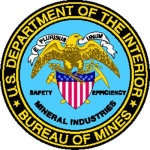- Branche: Mining
- Number of terms: 33118
- Number of blossaries: 0
- Company Profile:
The U.S. Bureau of Mines (USBM) was the primary United States Government agency conducting scientific research and disseminating information on the extraction, processing, use, and conservation of mineral resources.
Founded on May 16, 1910, through the Organic Act (Public Law 179), USBM's missions ...
A deposit formed by high-temperature magmatic emanations along an igneous contact.
Industry:Mining
A deposit formed contemporaneously with the parent rock and enclosed by it. There are two types of syngenetic deposits, igneous and sedimentary. Some examples are nickeliferous sulfides, nontitaniferous magnetite, diamond, chromite, and corundum.
Industry:Mining
A deposit made up mainly of rock material that has been expelled aerially, normally explosively, from a volcanic vent, such as agglomerate, tuff, and ash. The fragments range in size from bombs and blocks to dust or ash. Such deposits are usually designated according to the lavas to which they correspond in composition.
Industry:Mining
A deposit of diatomite of marine origin occurring on the island of Mors, Denmark. It has been worked since 1912 for use as a heat insulating material, as a constituent of special cements, and for other purposes.
Industry:Mining
A deposit of fossil-reef material overlying or covering an island or mountain.
Industry:Mining
A deposit of insoluble residue formed from the dissolution of the anode in commercial electrolysis. Sometimes called anode slime. In copper refining, this slime contains the precious metals that are recovered from it.
Industry:Mining
A deposit of oil, gas, or other minerals in sufficient quantity for production in paying quantities.
Industry:Mining
A deposit of ore in a lode having a small lateral, but considerable vertical extent. An older term for ore shoot.
Industry:Mining
A deposit of sand or gravel that contains particles of gold, ilmenite, gemstones, or other heavy minerals of value. The common types are stream gravels and beach sands.
Industry:Mining
